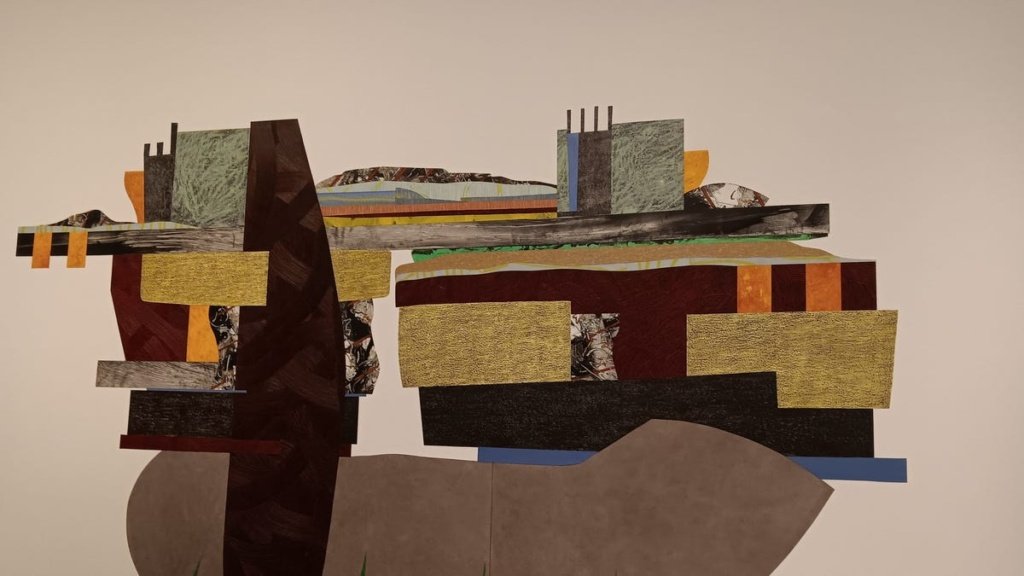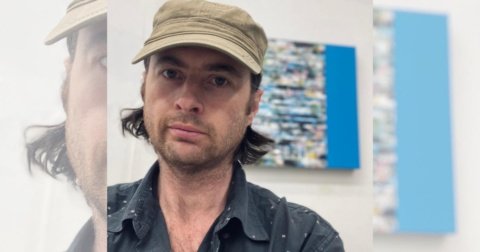Abstract artworks of Eric N. Mack, Nanette Carter and Veronica Ryan are on view at the Wexner Center for the Arts now until Jan. 11. Mimi Onuoha’s video completes the exhibition, blending actual photos with an artificial intelligence component.
Descending into the gallery space, one encounters billowing textile works by Eric N. Mack. The fabrics display a range of color and texture, reimagining abstract works of art. Mixing modern cloth and vintage fabric adds depth and layers to Mack’s works in the exhibition, “All the Oohs and the Aahs,” curated by Julieta Gonzalez. Some works, such as “Landlord” (2021), take on an architectural feel, incorporating found objects of metal brackets, wooden flag poles and an umbrella, which add shape and structure to the fabric.
History plays a part in Mack’s work by using vintage fabric and print images of cultural newspaper articles attached to fabric, as in “We make it easy, you make it home” (2020), depicting newsprint images and stories on racial inequity, violence and cruel treatment of animals in the fashion industry set on a quilted blanket. Mack marks a sharp distinction between garment culture, or the necessity of wearing clothes, versus fashion, which can be capricious and is based on appearance rather than utility.
In “The Box,” there is a continuously running video with images of family life. Assembled by Nigerian American artist Mimi Onuoha and curated by Jennifer Lange, the exhibition “Us, Aggregated 3.0” combines actual private photographs mixed with AI-generated images from Google, similar in content to the actual photographs seemlessly integrated with the human-generated photos. Onuoha makes the point that machine learning “often misrepresent(s) — human complexity.” The broader topics are grouped by category — dinner, cooking, vacation images of beaches, resorts and animals. Other images seem to have special significance for Onuoha. “Dad/Chief” examines leadership in the home and community. The female form is celebrated in “Standing,” with a variety of images of women posing for the camera, inviting the viewer’s gaze. Norway is the topic of very focused travel photos, sentimental reminders of a family vacation.
Abstract form is explored in Nanette Carter’s exhibition, “Afro Sentinals.” Carter was born in Columbus and grew up in Montclair, New Jersey, where she began taking art classes at the Montclair Art Museum as a child. Her collages are created with oil on mylar affixed directly on to the gallery wall with double-sided tape. The mylar is painted in various colors and textures lending a three-dimensional effect to her works. Gallery guide Dave Givler explained that Carter is very precise in recreating the works at each venue, giving a near identical appearance in each exhibition while being unique creations.
Carter also creates standing figures in steel, resembling the human form. These Sentinals are talisman-like figures, guardians and symbols of resilience evoking armor and ancestral presence. For Carter, these figures are invested with sacred energy. Photos of the Terracotta Army of the First Emperor of China, Qin Shi Huang (259-210 BCE) inspired this series. She is influenced by both African tradition and contemporary social justice, which she expresses through art.
Veronica Ryan’s exhibition, “Unruly Objects” features found and manufactured objects transformed into art raising issues about environmentalism and human impact. Ryan’s body of work spans more than four decades and includes more than 100 artworks.
Ryan was born in Monserrat and raised in London. She is part of the Windrush generation, referring to Caribbean emigrants to the UK after the Second World War, from 1948-1971. Ryan is also a Turner Prize-winning artist, who combines materials to create new forms and explores the Afro-Caribbean diaspora. Some of her inspiration is taken from nature, hand sewing seeds and beans into her artwork and using natural dyes.
Ryan has never forgotten her roots. Decades after her family left Monserrat, a volcanic eruption devasted the town of her birth. Ryan immortalized the town of Plymouth by creating a sculpture in marble embedded with cast replicas of soursop fruit, native to Monserrat. Ryan recalls shopping for tropical fruit with her mother in London.
What these artists have in common is drawing upon cultural heritage to tell visual stories about family, tradition and the longing for homeland. Carter, Mack and Ryan all create with abstract, which can be very personal and open to interpretation. If you would like to learn more about abstract art, visit the bookstore on the gallery level.
The Wexner Center for the Arts at Ohio State University is located at 1871 N. High St. in Columbus. Gallery hours are 9 a.m. to 6 p.m. Tuesday and Wednesday, 9 a.m. to 9 p.m. Thursday, 10 a.m. to 6 p.m. Friday, 10 a.m. to 8 p.m. Saturday, 10 a.m. to 6 p.m. Sunday, and closed on Monday. The exhibitions are free to attend accompanied by ticketed lectures and films. Check the schedule at wexarts.org for more information.
Amy Drake, M.A., M.S. MCM, is a Telly Award-winning filmmaker, playwright and actor. She can be reached at draketheatrical@gmail.com.


